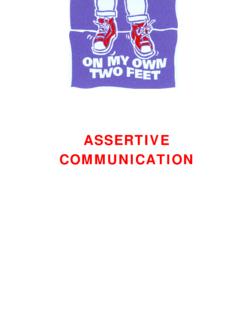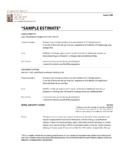Transcription of IDENTITY AND SELF ESTEEM - SPHE | Welcome
1 IDENTITY AND. self ESTEEM . This book is one of seven constituting On My Own Two Feet . Educational Resource Materials for use in Substance Abuse Education Worksheets may be copied for educational purposes free and without special permission. Permission for additional use may be obtained from Dept. of Education and Science, Marlborough St., Dublin 1, Ireland An Roinn Oideachais agus Eola ochta, Department of Education and Science An Roinn Sl inte agus Leana , Department of Health and Children Mater Dei Counselling Centre ISBN No. 086387 044 9. 2nd Edition 1997.
2 2. IDENTITY AND. self ESTEEM . 3. CONTENTS. INTRODUCTION 5. GRID OUTLINING MATERIALS 10. LESSON 1 GETTING TO KNOW YOU 14. LESSON 2 LEARNING TO LISTEN 16. LESSON 3 GROUP BUILDING 19. LESSON 4 CARDS 22. LESSON 5 THIS IS ME 27. LESSON 6 LIFELINE 30. LESSON 7 CHANGES 35. LESSON 8 MY HOPES 40. LESSON 9 FAMILY CREST 43. LESSON 10 THAT'S LIFE! 47. LESSON 11 SUNSHINE 51. LESSON 12 OPTION A FEEDBACK CIRCLE 55. LESSON 12 OPTION B POSITIVE POSTERS 58. LESSON 13 THINK POSITIVE 61. LESSON 14 SEX ROLES 64. LESSON 15 NOBODY'S PERFECT 68. LESSON 16 ACCEPTING POSITIVES 75.
3 4. INTRODUCTION. S. ELF ESTEEM is a concept used to convey the positive regard you have for yourself. It is based on your judgement of your own worth and importance. One's self -picture or self - image is influenced by one's interaction with others. It reflects the messages received and taken in about oneself from significant others' whether these messages are explicit or implicit, verbal or non-verbal, valid or invalid. It is important to realise that small children tend to accept without question most of what they're told about themselves. At that stage of development, children are unable to discriminate between valid and invalid criticism and believe many of the negative messages they receive.
4 If people can gain an understanding of how they can build and support their own self worth it will help considerably in the primary prevention of substance abuse. This understanding will also support preventive work in relation to many personal and interpersonal problems. Teachers who piloted these materials emphasised the need for repeated attention to this area of self ESTEEM , especially for students with a poor self image. One stage in developing self ESTEEM is receiving validation for just being yourself. In order to develop a sense of well being in oneself and to go out into the world with confidence, to try out what one has learned, it is important that the child or young person receives certain messages from others.
5 Parents are the ideal source of these messages, but any significant adult can give the child these messages grandparents, other relations, child-minders, youth leaders and teachers. Children need to know that they are loved and wanted. They need to experience consistency and trust and they need to have clear limits set for them. It is natural to want to be accepted, but if your view of yourself depends excessively on how others rate you, it will be very hard to act autonomously, to make a stand against peer pressure, to take risks, to defend a position and especially to handle criticism and rejection.
6 A goal of IDENTITY education must be to help people understand how they have come to have their current self image and to appreciate their own uniqueness and value even when other don't. This work on IDENTITY is therefore at the heart of healthy growth and development and will contribute to many areas of the child's life. 5. LOW self ESTEEM . While low self ESTEEM my not have a major part to play in the early stages of drug use, especially in relation to legal drugs, it is an important factor in the progression to abuse of drugs. Any effective work done in building self ESTEEM in school can contribute in a very important way to the prevention of drug abuse in later life.
7 It is crucial for responsible behaviour. Students with low self ESTEEM are very vulnerable in interpersonal relationships; they assume that others do not like them and they feel relatively isolated and lonely. Rosenberg (1965) found adolescents with low self ESTEEM to be awkward in social relationships; they maintained a defensive front; they indulged in boasting with a consequent fear of exposure; they were unable to maintain relationships in a consistent way; and they felt misunderstood and suspicious of others. Low self ESTEEM is manifested in Extreme concern with what other people think.
8 A lack of autonomy and individuality. Boasting or wanting to impress in order to disguise low self ESTEEM . Low self ESTEEM comes from such growing up experiences as: Absence of affection, encouragement, challenge. Conditional love and acceptance. Criticism, ridicule, sarcasm, cynicism. Physical beatings and abuse. Absence of recognition and praise for achievements. Uniqueness not being reinforced. It is reinforced within certain kinds of family and school systems. Troubled systems which foster low self ESTEEM are characterised by: Criticism for being different.
9 Punishment for mistakes. Distorted communication. Inflexible rules. 6. HIGH self ESTEEM . What does high self ESTEEM do for you? Having a strong rooted sense of self worth enables one to cope with both failure and success, to survive mistakes, disappointments and even rejection by others. It is built through the experience of being accepted by others but does not depend excessively on it. A person with high self ESTEEM feels good about all aspects of him/herself and accepts his/her limitations. People with high self ESTEEM show less anxiety and less stress under failure.
10 They are more socially effective, confident and ambitious. They look and feel good, they are effective and productive and they respond to other people and themselves in healthy, positive ways. They make better relationships, are less defensive, are able to handle criticism and don't brag and boast so much. People with self confidence and high self ESTEEM are less likely to abuse drugs. HOW IS HIGH self ESTEEM DEVELOPED? Coopersmith (1967) related it to: 1. Almost TOTAL acceptance of the child by his/her parents unconditional love. 2. Clearly defined and enforced limits of behaviour.












